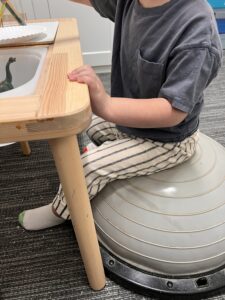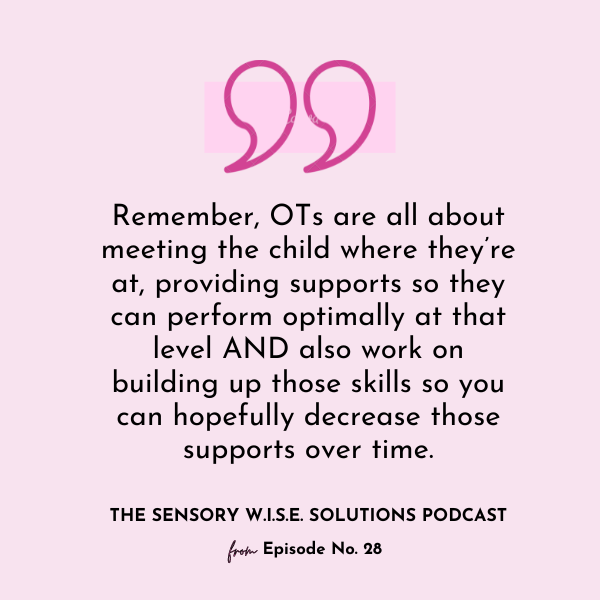Get your FREE sensory profiles cheat sheet >>click here<<
Development of handwriting skills and when to seek OT support
Did you know that development of handwriting skills depends on a solid foundation of sensory processing skills?
Really, all of our motor output (both gross and fine motor) become refined and developed after sensory skills have been established. So, it’s pretty common for some kids with handwriting challenges to have underlying sensory processing issues.
Continue reading to find out more about common handwriting development struggles, when it’s time to seek OT support for handwriting challenges, and how OT can help with supporting handwriting challenges.
Keep this in mind as you read this post
Please keep in mind, I’ll be talking specifically about the act of handwriting letters.
But remember, there are pre-writing shapes and strokes (like lines, circles, triangles) that need to be mastered before writing letters. I don’t even worry about improving handwriting (actual letter writing) in children until they’re in kindergarten. I could do a whole episode on placing too high demands on preschoolers these days, but instead I’ll link a blog post I co-wrote with Susie from BusyToddler.
To be clear, I do have clients who are preschool age that I do work on visual motor skills like drawing and some letter tracing, because those skills are part of their clinical picture and things that they need support with, BUT, I would not refer a preschooler to OT solely for handwriting difficulties if that makes sense.
Like if a 4 year old was having difficulty writing their name and that was their only issue, or was grasping a pencil awkwardly, I would not refer them to OT just for this reason.
If this 4 year old also had sensory processing issues, big behaviors, meltdowns, can’t put their socks or jacket on, then yes I would work with them in OT and would also probably add some drawing and coloring/tracing skills to our work.
So as you continue reading, remember that I’m talking about the skills leading up to handwriting development (letters and numbers) for kindergarteners or older.
Skills that are needed for handwriting letters
If we’re talking about the actual task of sitting down at a table, taking pen to hand and writing our name, what skills does a person need to have to successfully write the letters of their name?
Handwriting is classified as a visual-motor-integration skill, which is basically what it sounds like: integrating the visual sense and the motor senses to create an output.
But, there are many more underlying skills involved in handwriting.
Sensory processing skills and handwriting
Sensory processing skills are a huge foundational requirement to build fine motor, gross motor and even cognitive skills.
If you think of a pyramid where the top skill is handwriting, the bottom level, the foundation of the pyramid would be all of the sensory systems.
Without a refined, efficient sensory processing system, you can’t develop advanced skills.
- Visual perception- This is important for knowing where on the paper to start writing the letter, knowing how big letters should be, recognizing the letters, knowing to put spaces between letters and even bigger spaces between words.
- Tactile and proprioception perception- These senses contribute to knowing how to grasp the pencil in your hands and how much force to push when writing. If these senses are underdeveloped or unrefined, it can contribute to an awkward grasp, super light/shaky lines or super dark lines and a child who gets fatigued easily.
- Vestibular and proprioception perception- These senses combined contribute to maintaining an upright posture which is necessary for fine motor precision.
If your child has sensory processing difficulties related to any of those senses I mentioned (visual, tactile, proprioception, vestibular), it may be contributing to their development of handwriting skills.
When you work with an OT on handwriting skills, don’t be surprised if they spend half the session doing an obstacle course, or going outside or doing some other fun, full body movement activity, because they’re probably working on sensory integration.
Gross motor skills and handwriting
Did you know that gross motor development is also a requirement for the development of handwriting skills?
Without a solid gross motor foundation, fine motor skills can’t fully develop.
Gross motor skills develop before fine motor skills. Think about it, one of the first major milestones in infancy is being able to roll over, or even before that, to hold their neck up.
You would not expect a baby who can’t hold their head up or to roll over to be able to use a pincer grasp.
They work on tummy time to develop good core and postural stability, which then allows them to have stable shoulder and trunk musculature which will later contribute to having a functional grasp pattern.
Here are more ways gross motor development leads to fine motor and handwriting development:
- You need postural strength and endurance to sit upright. If you can’t sit upright, you can’t have proper control and movement of the muscles in the hand.
- Stability of the upper body muscles like the trunk and shoulder muscles so the fingers can move precisely.
If your child has been identified to have gross motor challenges with any of those skills mentioned, an OT might offer activities like:
- Weightbearing activities, such as crawling, animal walks, plank, especially when there is weight bearing through the hands. This is great for building postural support, shoulder and trunk stability.
- Sitting on an exercise ball while playing a table-top game or building something. Sitting on this unstable surface requires a lot of activation of the postural and core muscles needed for sitting upright.
- Laying on their tummy to play a board game or activity, which also builds trunk support and postural skills.

Fine motor skills and handwriting
This is probably the skill you expected me to mention first when talking about handwriting. But actually, it’s one of the last. Why? Because you need a steady set of gross motor skills and sensory processing skills in order to refine the development of fine motor skills.
Hopefully by now, you’re getting the picture that handwriting is not only a fine motor skill. But, of course, fine motor is a major component to handwriting.
Specifically:
- Fine motor precision. This is exactly what it sounds like. The actual motor ability to produce a line, a curve, a stroke in a precise way so that it can actually bump the line, or close the circle or produce a shape or letter that is legible. Difficulty with fine motor precision can result in illegible letters, letters that are too big, or not adhering to the writing space and lines provided.
- Fine motor strength, which includes strengthening the muscles in the fingers and in the hand. This is required for proper grasp of the writing utensil, applying enough pressure on the writing utensil, and to be able to sustain writing and drawing without getting easily fatigued (which, of course, varies by age).
Cognitive skills and handwriting
Executive functioning skills are a set of higher level cognitive skills that are really necessary for so many childhood developmental tasks. And a lot of executive functioning skills are necessary for developing handwriting. For example:
- Memory of the letters in your name
- The sequence of those letters and the motions or strokes required to to create those letters.
- Attention to the task
- Initiation and completion of the task
- Planning and looking for materials: you have to know to grab a pencil and a paper first before sitting down at the table.
And these aren’t even the actual motor parts related to writing. Can you start to see how handwriting is a complex skill?
So if your child has difficulty with executive functioning and you’re also working on developing handwriting skills, an OT might help build executive functioning skills with games like:
- Completing a multi-step craft that requires the child to follow instructions, find the materials and complete the task with little to no extra instruction other than a visual demonstration or a model of the completed craft
- Playing a spot the difference or “I spy” game to encourage visual memory, working memory, visual attention
- Color by number to practice visual memory, focused attention, initiation and completion, working memory.
There’s so much more an OT may do to build executive functioning skills to contribute towards handwriting, but they may also provide some accommodations to better support the child’s current level of executive functioning abilities like:
- Offering visual samples of letters or numbers
- Offering visual check lists or visual timers to help with managing time on a multi-step writing activity
- Giving step by step instruction for a craft or activity rather than expecting them to remember it all.
Remember, OTs are all about meeting the child where they’re at, providing supports so they can perform optimally at that level AND also work on building up those skills so you can hopefully decrease those supports over time.
Those were probably way more skills than you were expecting, right?
This is why when a child has difficulty with handwriting, an OT’s assessment can give you so much information on the underlying skills, and it’s why OTs are probably doing a lot of activities that don’t look like they’re working directly on handwriting.
How do I know if it’s time to seek OT for handwriting skills?
Now, I always get asked, by teachers and parents, how do you know when your child actually needs to be seen by an OT for their handwriting? So I’ll leave you with a quick checklist for you to think about.
It’s a two part checklist.
If your child displays any of the following signs (it could be just one, or many of them)
- Writing or drawing seems effortful for the child
- Child gets easily fatigued from writing or drawing (always shaking hands out, slows down)
- Child’s letters or drawings have very light, shaky lines
- When a visual sample of a letter or shape is provided, the child has a difficult time copying it.
- Are displaying behaviors related to handwriting (avoiding tasks, meltdowns)
- Have other tasks related to fine motor that seem hard for them (buttoning, zipping, using eating utensils, putting shoes on)
- Have other tasks related to visual processing that seem hard for them (puzzles, recognizing shapes/letters)
- Child is still consistently holding the pencil, crayon or marker with a fist or digital pronate (which is when their hand is kind of rotated so their thumb is closest to the paper rather than the pinky side of the hand down) in Kindergarten*

If any of those signs are happening, AND they are kindergarten or older
Then you would benefit from getting assessed by an OT.
If your child is in public school, you can ask the school to assess your child, and if your child qualifies, you can get support through a school based OT.
If your child doesn’t qualify for school based OT (they have some pretty strict requirements for qualifying children for OT), but you still want support, you can go to a private OT clinic.
I would start in a local mom’s facebook group or other local community support group and ask for private OT clinics in the area and call them up.
The person who does the intake there can usually give you the process of how to get referred by your pediatrician if needed, or any other things you may need in order to get the process rolling.

If you want help with that or any other help with OT, maybe you’re in between therapists, or are on a huge waitlist, I can help! I offer 1:1 consultations via zoom, head to www.theotbutterfly.com/parentconsult
Episode Links:
Transcript/show notes at www.theotbutterfly.com/28
instagram: @TheOTButterfly www.instagram.com/theotbutterfly
email: LauraPetix@TheOTButterfly.com
work with me: www.theotbutterfly.com/parentconsult







